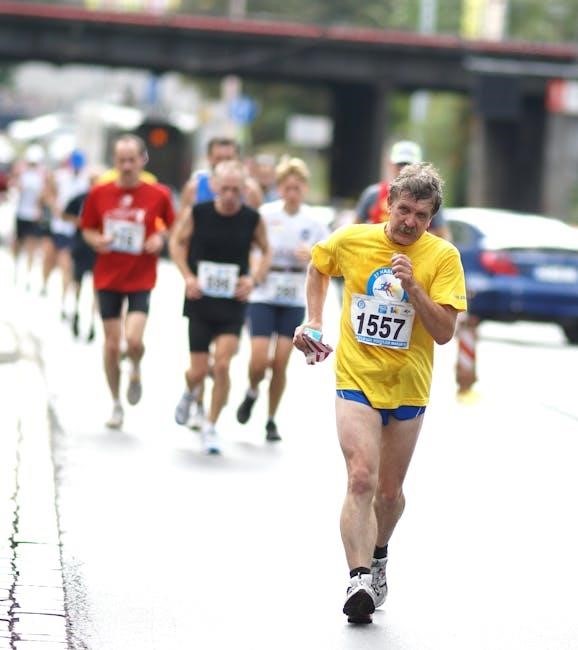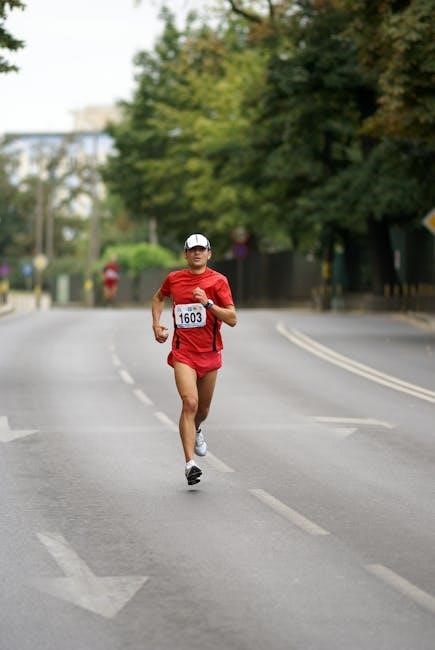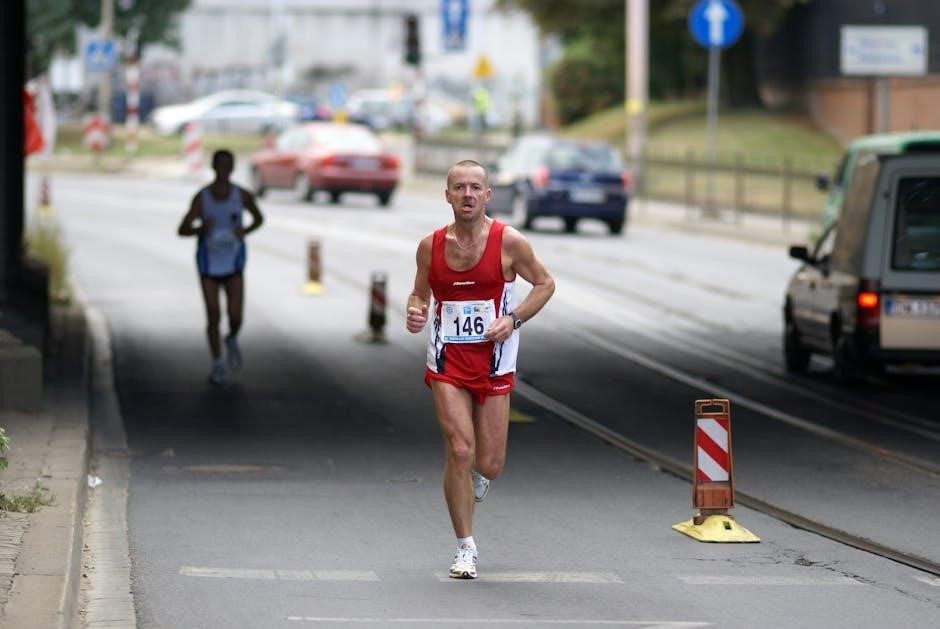Importance of Proper Running Shoe Fit
A proper running shoe fit is crucial for optimizing performance, preventing injuries, and ensuring comfort. It reduces discomfort, minimizes injury risks, and enhances overall running efficiency and experience.
1.1 How Proper Fit Impacts Running Performance and Comfort
A proper fit enhances running performance by allowing feet to function naturally, optimizing energy efficiency. It prevents discomfort, blisters, and long-term injuries, ensuring a smoother, more enjoyable run. Experts recommend ensuring adequate space for toe movement and natural foot alignment to maximize comfort and performance during runs.
1.2 Common Injuries Caused by Poorly Fitting Running Shoes
Poorly fitting running shoes often lead to blisters, calluses, and toe injuries. Tight shoes can cause bunions or hammertoes, while too much space may result in blisters. Heel slippage can lead to Achilles tendonitis, and inadequate arch support may trigger plantar fasciitis. Proper fit is essential to prevent these common running-related injuries and ensure long-term foot health.

Determining the Correct Shoe Size
Accurate shoe sizing involves measuring foot length and width. Some recommend adding a thumb’s width for toe room, while others emphasize matching foot shape to shoe size precisely.
2.1 How to Measure Foot Length Accurately
Measure foot length by placing the foot flat on the ground and using a ruler or Brannock device. Ensure the foot is fully extended, and measure from the heel to the longest toe. This step is crucial for determining the correct shoe size and ensuring a proper fit. Accuracy is key for comfort and performance.
2.2 The Debate: Should You Add a Thumb’s Width for Toe Room?
Adding a thumb’s width for toe room is a common recommendation to ensure comfort during runs. This allows toes to move naturally, reducing pressure and preventing blisters. However, individual preferences vary, so some opt for a snug fit while others prefer extra space. Proper fit is essential for optimal performance and injury prevention.
2.3 Understanding the Role of Foot Width in Shoe Sizing
Foot width plays a significant role in shoe sizing, as it ensures a comfortable fit. Narrow or wide feet require specific shoe widths to prevent discomfort or blisters. Accurate measurement of foot width helps in selecting shoes that provide adequate support and allow natural toe movement, enhancing overall running performance and comfort.

Foot Shape and Biomechanics
Foot shape and biomechanics significantly influence shoe choice. Factors like arch type, pronation, and gait patterns determine support needs, ensuring optimal comfort and performance during runs.
3.1 How Foot Shape (e.g., Flat Feet, High Arches) Affects Shoe Choice
Foot shapes like flat feet or high arches significantly impact shoe choice. Flat feet may require more supportive shoes, while high arches need cushioning. Proper selection ensures comfort and prevents injuries, adapting to individual foot structures for optimal performance and reduced discomfort during runs.
3.2 The Role of Gait Patterns (e.g., Overpronation, Supination)
Gait patterns like overpronation and supination play a crucial role in shoe selection. Overpronation requires supportive shoes with stability features, while supination needs cushioned footwear. Understanding your gait helps prevent injuries, improves comfort, and enhances running efficiency by addressing specific foot movement needs during each stride.
Choosing the Right Features in Running Shoes
Selecting features like cushioning, support, and breathability ensures optimal performance. These elements cater to running styles, terrain, and personal preferences, enhancing comfort and durability for better running experiences.
4.1 Cushioning and Support: What’s Right for Your Running Style
Cushioning and support in running shoes are tailored to your running style. High cushioning suits long-distance runners for comfort, while maximum support is ideal for those with flat feet or pronation issues. Lightweight designs are best for speed, ensuring a balance between impact absorption and responsiveness during each stride. Proper cushioning enhances performance and reduces injury risks.
4.2 Heel-to-Toe Drop: How it Affects Your Stride
Heel-to-toe drop significantly impacts your running stride by influencing foot strike patterns. Lower drops promote a midfoot or forefoot strike, enhancing natural gait and reducing heel stress. Higher drops offer more cushioning but may alter running mechanics. Choosing the right drop depends on your running style, foot shape, and personal comfort to optimize performance and minimize injury risks;
4.3 Breathability and Durability: Key Features to Consider
Breathability ensures cool, dry feet during runs, preventing discomfort. Durable materials, like sturdy soles and reinforced uppers, extend shoe lifespan; Both features are crucial for performance and comfort, ensuring shoes withstand mileage while keeping feet fresh and supported throughout workouts and training sessions.
Understanding Running Styles and Terrain
Running styles and terrain significantly influence shoe choice, with varying needs for cushioning, traction, and support. Matching shoes to your training surfaces ensures optimal performance and comfort.
5.1 How Training Volume and Intensity Influence Shoe Choice
Higher training volumes and intensities demand shoes with enhanced cushioning and support to absorb impact and reduce fatigue. Increased mileage requires sturdier materials, while high-intensity workouts benefit from responsive midsoles for better energy return and stability.
5.2 Running Surfaces: Road, Trail, or Track Shoes
Different running surfaces require specific shoe features. Road shoes offer lightweight cushioning for pavement, while trail shoes provide durability and traction for uneven paths. Track shoes are designed for speed, with responsive midsoles and firm support. Choosing the right shoe for your surface ensures optimal performance, comfort, and reduces injury risk during runs.

Building a Running Shoe Rotation
A shoe rotation extends shoe lifespan and prevents overuse injuries. Alternate between pairs based on training volume, intensity, and surfaces for optimal comfort and durability.
6.1 Why You Need Multiple Pairs of Running Shoes
Having multiple pairs allows shoes to rest, extending lifespan and preventing breakdown. It also reduces injury risk by varying stress on feet and ankles during different runs and terrains.
6.2 Tips for Rotating Shoes to Extend Their Lifespan
Rotate shoes every 300-500 miles or 3-6 months. Alternate between pairs for different runs to allow cushioning to rebound. Track usage and replace worn-out models to maintain support and performance, ensuring optimal comfort and durability for your runs.

Step-by-Step Guide to Trying On Running Shoes
Try shoes in the afternoon for the best fit. Wear your usual running socks and orthotics. Assess comfort, support, and space for your toes during the try-on.
7.1 When to Try On Shoes (Time of Day Matters)
Always try on running shoes in the afternoon, as feet tend to swell throughout the day. This ensures a comfortable fit and accounts for any size changes, reducing discomfort during runs.
7.2 What to Wear: Socks and Orthotics
Wear your usual running socks and any orthotics when trying on shoes to ensure an accurate fit. This helps in assessing comfort, support, and overall feel, making the try-on process more effective for your specific needs.
7.3 How to Assess Comfort and Fit During the Try-On
Assess comfort by ensuring no tight spots or slipping. Check heel fit, toe room, and midfoot support. Walk or run briefly to gauge how the shoes feel in motion, ensuring they provide the right balance of cushioning and stability tailored to your running style and preferences.
Troubleshooting Common Fit Issues
Identify signs like blisters, heel slippage, or tightness. Adjust lacing, consider orthotics, or explore different sizes/styles to resolve discomfort and ensure proper support during runs.
8.1 Signs Your Running Shoes Don’t Fit Properly
If your shoes don’t fit well, you may experience blisters, heel slippage, or numbness. Look for signs like consistent discomfort, tightness, or uneven wear patterns. These indicators suggest improper fit.
- Blisters or hotspots during runs
- Heel slippage or lack of support
- Tightness or numbness in the toes
- Uneven shoe wear
- Persistent discomfort or pain
8.2 How to Fix Issues Like Blisters or Heel Slippage
To address blisters or heel slippage, try adjusting lacing techniques or using blister pads. Ensure proper fit by replacing shoes if necessary. Orthotics or insoles can also provide additional support and prevent recurring issues.
- Adjust lacing to reduce pressure
- Use moisture-wicking socks
- Apply blister pads or bandages
- Consider orthotics for support
8.3 When to Replace Your Running Shoes
Replace running shoes when they show significant wear, lose cushioning, or cause discomfort. Typically, shoes should be replaced every 300-500 miles or when soles are worn down. If they feel flat or cause pain, it’s time for a new pair to prevent injuries and maintain performance.
- Check for sole wear and tear
- Notice if cushioning feels flat
- Replace immediately if causing pain
Expert Advice and Resources
Consult podiatrists and running coaches for personalized shoe fit advice. Use reliable guides and reviews to make informed decisions and find the best fit for your needs.
9.1 Tips from Podiatrists and Running Coaches
Podiatrists and coaches emphasize proper fit, considering foot shape and running style. They recommend regular shoe rotations and trying shoes later in the day for optimal comfort and support.
9.2 Where to Find Reliable Shoe Fit Guides and Reviews
Reputable sources like specialty running stores, podiatrist recommendations, and trusted websites offer detailed guides and reviews. These resources provide insights into shoe features, fit, and performance, helping runners make informed decisions.
Final Thoughts: Putting It All Together
By considering fit, features, and personal needs, runners can select ideal shoes. Prioritizing comfort and support ensures enhanced performance and injury prevention, making every run enjoyable and effective.
10.1 Summarizing Key Takeaways for the Perfect Fit
A proper fit enhances comfort, performance, and reduces injury risks. Consider foot shape, gait, and training needs. Try shoes at the right time, wear correct socks, and ensure adequate toe room. Rotate shoes to extend lifespan and replace them when worn. Prioritize comfort and support for a confident, enjoyable running experience.
10.2 Encouragement to Prioritize Comfort and Support
Investing in shoes that prioritize comfort and support ensures a more enjoyable and injury-free running experience. Proper fit and features like cushioning and breathability can elevate performance. By focusing on your foot health and alignment, you create a foundation for peak performance and long-term running success.
